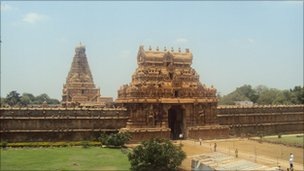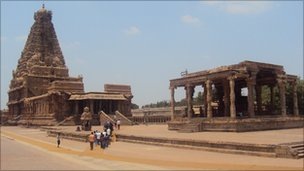 Official celebrations are taking place in southern India for the 1,000th birthday of one of the grandest temples ever built on the subcontinent.
Official celebrations are taking place in southern India for the 1,000th birthday of one of the grandest temples ever built on the subcontinent.
The Brihadisvara temple – in the town of Thanjavur, 350km (220 miles) south-west of Chennai – is considered the finest example of southern Indian architecture.
R Nagasami, the state of Tamil Nadu government’s retired director of archaeology, says it is not clear when work started on the attraction, which is better known as the Big Temple.
She adds: "But we can definitely say it was completed in the year 1010. We made this conclusion from stone inscriptions."
Unlike other Hindu temples built during that period, this one was made using granite.
Dedicated to Lord Shiva, a major Hindu deity, it consists of 13 tiers, and its main tower soars majestically to a height of 60m (200ft).
The master designers built the hollow tower by interlocking stones without using any binding material.
Chola dynasty
Considered one of the tallest structures in India at that time, the temple was built on the orders of the King Raja Raja Chola, the most prominent sovereign of the Chola dynasty.
The Cholas reached their zenith during the 11th Century, subduing smaller kingdoms and bringing most of southern India under their rule.
They were also pioneers in naval warfare, carrying out hostile waterborne expeditions to Sri Lanka and the Far East.
Raja Raja Chola, who ruled from 985 AD to 1014, was a Saivite, a branch of Hinduism that worships Lord Shiva.
His capital was the town of Thanjavur, situated on the banks of the River Cauvery, which is considered sacred by Hindus.
"King Raja Raja was also known as Sivapada Sundaran [which means a man devoted to the feet of Shiva]," says Mr Nagasami.
"Temple inscription says he first placed all the spoils of war at the feet of god and sought blessing from the almighty."
Rock transported
The temple is 240m long and 120m wide. There was no rock formation near the temple, so it had to be transported from quarries 50km away.
It is believed the rock was brought to the building site by river boat.
PS Sriraman, assistant superintendant archaeologist of the Archaeological Survey of India, says: "If you compare Big Temple with other temples of that time, it is at least 40 times bigger.
 "This is a dramatic scaling up. It shows their confidence and imagination. It has a very unique design. It is the first Hindu temple to be built on such a grand scale."
"This is a dramatic scaling up. It shows their confidence and imagination. It has a very unique design. It is the first Hindu temple to be built on such a grand scale."
Interestingly, the temple also has number of statues and stone carvings depicting the life of Buddha.
V Ganapati Sthapati, a well-known temple architect, says: "The temple tower incorporates the same building principles used in the construction of great pyramids.
"They designed the temple using traditional knowledge which is held as family secrets, and passed down from father to son. They carved out rocks using hand-held tools."
The inscriptions found in the temple have helped scholars understand the Chola empire.
‘Excellent condition’
The temple, which also has fresco paintings, has survived the ravages of countless monsoons, six recorded earthquakes and a major fire.
It is now maintained by the Archaeological Survey of India, a central government body.
Its superintendant archaeologist, Sathyabama Badrinath, says: "The temple is in excellent condition. It has no structural problems.
"The weight load is evenly distributed among pillars and beams. It needs very little maintenance."
Unlike its sound structure, patronage for the temple is somewhat shaky.
Soon after its completion, its chief patron Raja Raja died.
His son, Rajendira I, succeeded him. He was a far more successful military leader and wanted to build a much bigger version of the Big Temple.
He shifted the capital of the Chola kingdom to Gangaikondacholapuram, about 60km away, and started building a new temple there.
"Raja Raja had donated large tracts of land to provide money to maintain the temple. But Rajendira Chola diverted all these revenues to his newly built temple," says Mr Badrinath.
Why Rajendira did this still baffles historians today.
His decision deprived the Big Temple of royal patronage.
As artisans went to work at his new temple, work on the Big Temple began juddering to a halt.
But Rajendira was only able to build a smaller version of the Big Temple.
Further down the line, the Cholas built hundreds of temples along the banks of the River Cauvery, changing its landscape forever.
None of the forts and palaces built by the Cholas survives today.
But the remaining temples stand testimony to their achievements and are a major tourist attraction for both local and foreign visitors.
There are, however, concerns about the up-keep of the Big Temple.
Recently, an ill-conceived move to drill a bore-well just a few metres away from the main structure had to be stopped by a court order.
Increasing commercial and construction activities near the temple has prompted local authorities to impose tighter building restrictions.
(For updates you can share with your friends, follow TNN on Facebook and Twitter )
